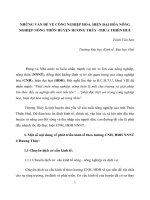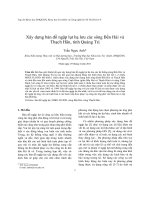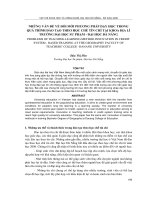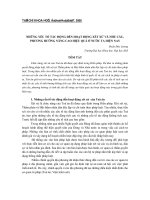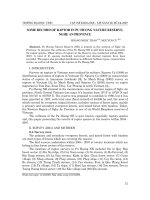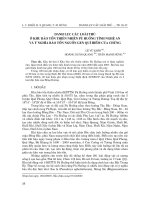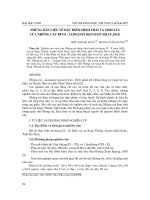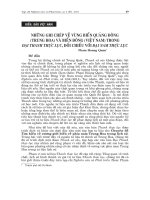Báo cáo nghiên cứu khoa học: "Những ghi nhận về chim ăn thịt ở khu Bảo tồn thiên nhiên Pù Huống, tỉnh Nghệ An" docx
Bạn đang xem bản rút gọn của tài liệu. Xem và tải ngay bản đầy đủ của tài liệu tại đây (233.01 KB, 6 trang )
tr−êng §¹i häc Vinh T¹p chÝ khoa häc, tËp XXXVIII, sè 2A-2009
75
Some RECORD OF RAPTOR IN PU HUONG NATURE RESERVE,
NGHE AN PROVINCE
Hoang Ngoc Thao
(a)
, Nguyen Cu
(b)
Abstract. Pu Huong Nature Reserve (NR) is located in the western of Nghe An
Province. At present, the avifauna of the Pu Huong NR is still little known, especially
for raptor species. Observation of raptors in the Reserve was conducted within 2004 -
2007. A total of 21 species (included nocturnal and diurnal raptors) have been
recorded. The paper also provided distribution in different habitats types, conservation
status, as well as all threats to the raptors in Pu Huong NR.
I. INTRODUCTION
Surveys on raptors in Vietnam were realized by authors: Nguyen Cu (1998) on
distribution and status of raptors in Vietnam [7]; Nguyen Cu (2000) on conservation
status of raptors in Annamese Lowlands [9]; Le Manh Hung (2002) survey on
raptors in Vietnam [3]; Le Manh Hung and Nguyen Cu (2005) survey on raptor
migration in Tam Dao, Xuan Thuy, Cuc Phuong in north Vietnam [4]…
Pu Huong NR situated in the mountainous area of western region of Nghe An
province, North Central Vietnam (see map). It’s location from 19
0
15' to 19
0
29' N and
from 104
0
43' to 105
0
00' E. The reserve was proposed to establish in 1986, but it has
been gazetted in 1997, with total area (final revised) of 49,806 ha and, the most of
which covered by evergreen tropical forests, includes various of forest types, mainly
a primary and secondary evergreen forests, and mixed forest with bamboo. Today,
the Western Region of Nghe An Province is one of six World Biosphere reserves of
Vietnam.
The avifauna of the Pu Huong NR is poor known, especially raptors species
and, this paper presenting the results of raptor species in the reserve within 2004 -
2007.
II. SURVEY AREA and Methods
2.1. Survey area
The primary and secondary evergreen forests, and mixed forest with bamboo
are main types of forests which are covering the reserve.
The bird surveys undertaken within 2004 - 2007 at twenty locations which are
belong to four forest sectors of the reserve:
The locations of raptor surveys in Pu Huong NR included Six in Quy Hop
forest sector: (1) Ha Na ridge, (2) Cay Xoan camp, (3) Co stream, (4) Bo Doi road, (5)
Hin Dong stream, (6) La Han stream; Eight in Quy Chau forest sector: (7) Cuom
village, (8) Nhap stream, (9) Phep stream, (10) Phep slope, (11) Cay De camp, (12)
Bo stream, (13) Trang Tranh stream, (14) Cua stream; Four in Que Phong forest
sector: (15) Ta village, (16) Ta slope, (17) Huoi Lac stream, (18) Ton stream; Two in
Tuong Duong forest sector: (19) Na Kho village and (20) Kho stream.
NhËn bµi ngµy 11/2/2009. Söa ch÷a xong 27/5/2009.
H. N.c Thao, N. Cu Some RECORD OF RAPTOR IN PU HUONG NATURE , Tr. 75-80
76
Following map shows Pu Huong NR in Nghe An Province:
2.2. Methods
Raptors were observed by as common methods used such as binoculars and
together calling heard at night for the most of owl species. Using drawings, photos
in the field guide books on observing natural birds: Boonsong Lekagul, Philip D.
Round, 1991 [1]; Nguyen Cu, Le Trong Trai, Karen Phillipps, 2000 [8]; Field
guidebook on birds of Asian South East by Craig Robson, 2000, etc. [10].
Using some raptor specimens which are maintaining in the bird collection of
Vinh University, Nghe An Province. Some species were recorded by documents [5,
6].
III. RESULT AND discussion
3.1. Species composition of raptor in Pu Huong NR
Species composition of raptor in Pu Huong NR shows in table 1.
Table 1: List of raptors were recorded in Pu Huong NR
No
Species Localition (a)
Number
of record
Remark
Falconiformes
Hawks, Eagles
Accipitridae
1 Black Baza
Aviceda leuphotes (Dumont, 1820)
(*)
Doc.
tr−êng §¹i häc Vinh T¹p chÝ khoa häc, tËp XXXVIII, sè 2A-2009
77
No
Species Localition (a)
Number
of record
Remark
2 Black-shoudered Kite
Elanus caeruleus (Desfontaines, 1789)
(*)
Doc.
3 Black Kite
Milvus migrans (Boddaert, 1783)
8,12
2
S
4 Crested Serpent Eagle
Spilornis cheela (Latham, 1790)
7,8,9,12
6
S, C,
Doc.
5 Grey-faced Buzzard Eagle
Butastur indicus (Gmelin, 1788)
9
1
S
6 Asian Crested Goshawk
Accipiter trivirgatus (Temminck, 1824)
9
1
S, Doc.
7 Japanese Sparrowhawk
Accipiter gularis (Temminck &
Schlegel, 1844)
9
1
S
8 Eurasian Sparrowhawk
Accipiter nisus (Linnaeus, 1758)
(*)
Doc.
9 Indian Black Eagle
Ictinaetus malayensis (Temminck,
1822)
8,12,13,19
4
S
10
Rufous-bellied Eagle
Hieraaetus kienerii (Geoffroy Saint-
Hilaire, 1835)
(*)
Doc.
11
Mountain Hawk Eagle
Spizaetus nipalensis (Hodgson, 1836)
9,12,13
4
S
Falconidae
12
Pied Falconet
Microhierax melanoleucos (Blyth, 1843)
(*)
Doc.
13
Common Kestrel
Falco tinnunculus Linnaeus, 1758
(*)
Doc.
14
Oriental Hobby
Falco severus Horsfield, 1821
(*)
Doc.
Strigiformes
Owls - Strigidae
15
Mountain Scops Owl
Otus spilocephalus (Blyth, 1846)
2,7,8,11,12,13
6
C
16
Collared Scops Owl
Otus bakkamoena Pennant, 1769
9,13,17
4
C
H. N.c Thao, N. Cu Some RECORD OF RAPTOR IN PU HUONG NATURE , Tr. 75-80
78
No
Species Localition (a)
Number
of record
Remark
17
Collared Owlet
Glaucidium brodiei (Burton, 1836)
1,3,4,8,9,12,13, 14,
18,20
13
C
18
Cuckoo Owlet
Glaucidium cuculoides (Virgors, 1831)
1,3,4,5,6,8,9,10,12,
13,14,16,18,20
37
C, Doc.
19
Brown Hawk Owl
Ninox scutulata (Raffles, 1822)
8,9
4
C, Doc.
20
Brown Fish Owl
Ketupa zeylonensis (Gmelin, 1788)
(*)
Doc.
21
Brown Wood Owl
Strix leptogrammica Temminck, 1831
(*)
Doc.
Remark: (a) The numbers 1, 2, … 20, see Survey areas; (*) Species were recorded by
documents [5, 6].
The total of 21 species (included nocturnal and diurnal raptors) belonging to 3
families has been recorded in Pu Huong NR. Among them, Accipitridae have
species’s number is highest (11 species, 52,38% total species were recorded);
Falconidae have 3 species (14,29% of total recorded species), and Strigidae have 7
species (33,33% of total recorded species).
Table 2: Comparison on raptors species between Pu Huong NR and Vietnam
Family Vietnam Pu Huong NR % of Vietnam
Accipitridae 39 11 28,21%
Falconidae 15 3 20,00%
Strigidae 15 7 46,67%
A total 69 21 30,43%
The quantity of species in the same families in Vietnam and Pu Huong NR
were presented as above tab. 2. Accipitridae included 11/39 species (28,21% in total
species), Falconidae: 3/15 species (20%) and Strigidae 7/15 species (46,67%).
3.2. Distribution of raptor in Pu Huong NR
In Quy Chau and Quy Hop forest blocks there are a big number of raptor
recorded, especially the owlet species in Quy Chau (Cuckoo Owlet was observed 37
times in 14 localities; Collared Owlet - 13 times in 10 localities and, Mountain Scop
Owl - 6 times in 6 localities). It is considered as to cause by a good forest remaining
and, the activities of logging and hunting didn’t so high in the past time.
The number of records of Accipitridae and Falconidae species during surveys is
low such as Crested Serpent Eagle had seen 6 times, Indian Black Eagle, and
Mountain Hawk Eagle - 4 times. There is only one record of each species such as
Grey-faced Buzzard Eagle, Asian Crested Goshawk and Japanese Sparrowhawk.
tr−êng §¹i häc Vinh T¹p chÝ khoa häc, tËp XXXVIII, sè 2A-2009
79
The distribution of bird species in habitats types is unfixed due to their
movement. The birds often move from this habitat to others at random, and it is also
strongly depending on different biological features of each species.
The most raptors can be observed in different habitats types of the reserve,
such as Crested Serpent Eagle, Grey-faced Buzzard Eagle, Asian Crested Goshawk,
Japanese Sparrowhawk, Indian Black Eagle, Mountain Hawk Eagle and Black Kite.
However, many Owls have been found mostly in the secondary forests and
along the bank of streams of the reserve. Such as Cuckoo Owlet, Collared Owlet,
Collared Scops Owl, Mountain Scops Owl usually found in secondary forests, side
forest habitat, secondary bushy barren or residential area.
3.3. Conservation status
A total 21 species of raptor have the importance value for gene source
conservation: they were listed in App. II of CITES 2003 [2]. Among them, there are 2
species were listed in Decision Number 32/2006 of the Government of Vietnam in
group IIB are Crested Serpent Eagle Spilornis cheela and Brown Fish Owl Ketupa
zeylonensis.
3.4. The threats are impacting to the raptors in the reserve
Logging of timber and non-timber products is happening in some of forest
sectors of the reserve.
Illegal exploitation and hunting natural resources, especially wild animals for
commercial purposes, foods and trading are still common.
Law enforcement is limitted in the region as well as inside the reserve.
Forest fire for expanding agriculture land is happening in some the parts of
the reserve.
The knowledge on the conservation of local people, especially ethnic groups are
low, and their life continuing to depending on the forest resources.
REFERENCES
[1] Boonsong Lekagul, Philip D. Round, A field guide to the birds of Thailand, Saha
Karn Bhaet Co. Ltd., Thailand, 1991.
[2] CITES 2003, List species database, UNEP-WCMC Species database: CITES-
Listed Species.
[3] Le Manh Hung, Notes on raptors observed during bird surveys in Vietnam:
October 2001 - July 2002, Bulletin of the Asian Raptor Research & Conservation
Network, No.3: December 2002, pp: 1 - 6.
[4] Le Manh Hung and Nguyen Cu, Raptor migration survey in North Vietnam
during autumn 2004 and spring 2005, Proceedings of the 4
th
Symposium on
Asian raptors, Taiping, Perak, Malaysia, 28 - 31 October, 2005.
[5] Management board of Pu Huong Nature Reserve, The project investing and
building up Pu huong Nature Reserve project, Nghean province, 5/2002.
H. N.c Thao, N. Cu Some RECORD OF RAPTOR IN PU HUONG NATURE , Tr. 75-80
80
[6] Neville Kemp and Michael Dilger, Site Description and Conservation Evaluation:
Bu Huong Proposed Nature Reserve Quy Chau District, Nghe An Province,
Vietnam, The Society for Environmental Exploration and Xuan Mai Forestry
College, in Collaboration with The Ministry of Forestry, Hanoi, 1996.
[7] Nguyen Cu, Present distribution and status of raptors in Vietnam, Proceedings of
The First Symposium on Raptors of Asia, Lake Biwa Museum, Shiga, Japan.
December 12 - 13, 1998.
[8] Nguyen Cu, Le Trong Trai, Karen Phillipps, Birds of Viet Nam, Society and
Labour Publishing house, 2000.
[9] Nguyen Cu, Conservation status of raptors in Annamese Lowlands, Proceedings
of The 2
nd
Symposium on Raptors of Asia, Bandung, Indonesia, July 25 - 27,
2000.
[10] Robson, C. R., A field guide to the Birds of South-East Asia, Bangkok: Asia
Books, 2000.
Tóm tắt
Những ghi nhận về chim ăn thịt ở khu Bảo tồn
Thiên nhiên Pù Huống, tỉnh Nghệ An
Khu Bảo tồn Thiên nhiên Pù Huống nằm ở phía Tây tỉnh Nghệ An. Những
nghiên cứu về khu hệ chim ở khu BTTN Pù Huống còn ít đợc biết đến, đặc biệt là
các loài chim ăn thịt. Những dẫn liệu về nhóm chim ăn thịt đợc thực hiện dựa trên
kết quả các đợt khảo sát nghiên cứu chim ở khu bảo tồn từ năm 2004 - 2007. Có tổng
số 21 loài (bao gồm nhóm chim ăn thịt đêm và chim ăn thịt ngày) đã đợc ghi nhận.
Bài viết cũng chỉ ra phân bố của các loài chim ăn thịt ở các dạng sinh cảnh khác
nhau, tình trạng bảo tồn, cũng nh các mối đe doạ đến các loài chim ăn thịt ở khu
BTTN Pù Huống.
(a) Faculty of Biology,
Vinh University
(b) Vietnamese Academy of Science and Technology.


